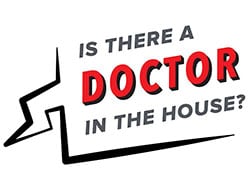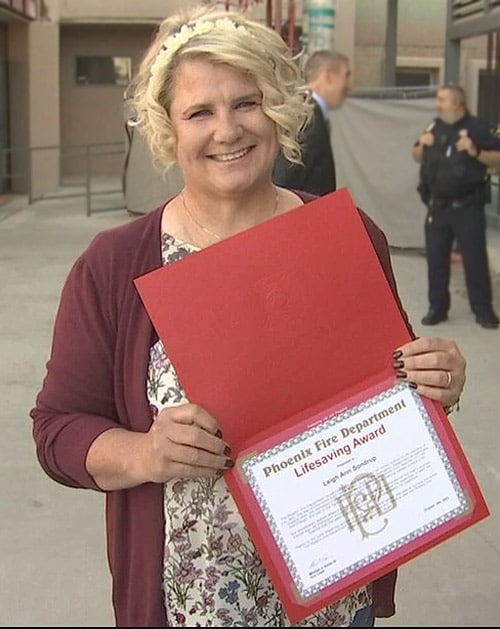
Emergencies happen anywhere, anytime, and sometimes medical professionals find themselves in situations where they are the only ones who can help. Is There a Doctor in the House? is a Medscape series telling these stories.
I was driving home after a night shift in the ED. Morning rush hour in Phoenix. I was super tired, and that's usually when I become more aware of what's going on around me. Coming down Route 143 by the airport, I saw a cloud of smoke. Not like fire smoke. It was more like dust rising in the air. I thought, It must be construction.
Sure enough, as I got closer, I could see a cement truck. But it was turned on its side. And that's when I realized: Accident.
It had only just happened. And there was no EMS there. I instantly knew I had to stop.
The truck was on the other side of the freeway lying against a retaining wall, part of an on-ramp from another freeway. So, I pulled over into the gore point on my side (that triangular stretch between a main road and exit ramp).
I grabbed some gloves and my phone and got out. And then I was facing two lanes of speeding traffic. I thought, Don't get hit, don't get hit.
All of a sudden there was a huge break in the traffic. It was like a little blessing, and I crossed. I hopped over the retaining wall and did a quick scene assessment. Fuel and concrete were pouring out of the truck. The back of it had taken out part of the wall, but the cab was still resting on top of it.
A couple of guys stood there, airport workers who had just finished their shift. They clearly didn't know what to do. I said, "I need you guys to keep an eye on this truck. If anything moves or if you see sparks, let me know, so we can be safe."
I called 9-1-1 and started talking to them. Then I crawled under the cab to look for the driver. It was ugly.
The door of the cab was gone. I could see the driver's left leg, vertical, coming down from the cab and standing on the ground. Blood poured from his thigh. His right leg was horizontal, up in the cab, and I could see his tibia and fibula exposed. I couldn't see his upper body, which was inside resting against the roof.
I started with the ABCs. The man was alert and able to speak to me, so I knew he had an airway and was breathing. But circulation would become an issue if he continued to bleed. He was in shock, not really registering any pain.
"Does anyone have a belt?" I yelled.
A guy gave me one, and I got it around the man's leg and pulled as tight as I could. I was still on the phone with 9-1-1, so I told them, "I'm applying a tourniquet on the driver's leg right now. Mark the time." Because time is tissue.
In order to keep the pressure, I had to stay there holding the belt in place. I kept talking to the driver, but it was a blind conversation. Because of the way he was positioned, we never saw each other's faces. I got his name, birthdate, allergies, basic history. Whenever I saw more blood coming out, I pulled harder on the belt.
Since my hospital was the closest one to the airport, I figured he would probably be going to our trauma bay. While I was holding this belt, I called my manager and gave her a report.
(Later I found out that she mentioned to another nurse, "I just got the strangest call from Leigh Ann. Something about a tourniquet and a cement truck.")
The driver kept saying, "I'm gonna die. I'm gonna die today."
Now, as a nurse, I am not one to blow smoke up anybody's skirt. I am not going to tell somebody something that I don't firmly believe. I told this guy, "You are not dying today."
I was a bit shocked when the words came out of my mouth, but I believed it with all my heart.
Time started to move very slowly. It felt like we were waiting forever for EMS to get there, but it was probably 10 minutes. In the meantime, I asked one of the guys to go to my car and grab my scissors. I thought the driver's pants might be stuck, and if we could cut them off, maybe we could pull him out.
I did that, but his foot was still trapped. I thought, He could be bleeding in there. I asked for another belt and applied it around that shin.
I kept going through all the what-ifs. What am I going to do next? What's my plan B? I'll keep him stable in this position for as long as I can. What happens when he's no longer stable?
And a big one: If this truck starts to fall, what's my exit plan?
EMS finally arrived, and I gave them a quick update. They had a real tourniquet, so we slid it up over the top of mine and applied that. Then I crawled out so they could work on extricating him.
Later, when I was standing off to the side, one of the captains from the fire department asked me, "Did you put that tourniquet on?"
I said sheepishly, "Yeah, I did. Am I in trouble?"
He said, "You know, you probably saved this guy's life."

Leigh Ann Sondrup, RN
I keep thinking about small blessings. The fact that there were people there to help ― people who wear belts. The fact that it happened early in the morning when it wasn't 100+ degrees outside. That his cab landed on that retaining wall so I could get under there to help him. That the cement roller didn't break loose and fall into traffic. That I left work at that time, not 5 minutes earlier or later. Little tender mercies.
When they got him to the hospital, he was unresponsive, had a systolic BP of 50, and no femoral pulses. But because of my call, they were ready with mass transfusion protocol and quickly got him into surgery. He ended up losing his foot but kept the leg where I had placed the first tourniquet.
Later that day, I went up to the ICU. He was intubated but not fully sedated. He opened his eyes, and I said, "I'm the lady that was helping you today. I told you you were going to make it." He tried to say something but couldn't. I said, "You're in good hands. You're going to be okay."
I saw him again after he got downgraded. He'd been extubated at this point. "I don't know why I'm still here," he said.
"You get a lifetime to figure that one out," I replied.
This accident made me think of how I lost my mom and my stepdad to a tragic accident. As horrible as that was, it was also a blessing, because neither of them knew a day without the other. And they didn't suffer.
I believe when it's your time, it's your time. I am still grateful for the people who tried to help them that day, even though it was futile.
To step up, especially if you haven't been trained, is scary. But people can become the heroes this world needs if we educate them. Basic first aid, CPR, Stop the Bleed. They can go a long way in saving someone's life.
One of my brothers posted about the accident on Facebook, and a TV station reached out about an interview. I wasn't sure, but my brother said, "Leigh Ann, you need to do this. Because people need to know that there's good in this world and that you can make a difference."
He's right. If people see one person doing something good for others, maybe they'll do the same when it's their turn.
I drive by that spot every time I go to work or come home, and I think about finding joy in adversity. Sometimes it's just a tiny little thing where you can say, "That was lucky. That was beautiful. Things can always be worse."
Leigh Ann Sondrup, RN, is an emergency nurse with Valleywise Health in Phoenix, Arizona.
Are you a medical professional with a dramatic story outside the clinic? Medscape would love to consider your story for Is There a Doctor in the House? Please email your contact information and a short summary to access@webmd.net.
Read more in the series:
A Mid-Marathon Cardiac Arrest, a Doctor's Crisis of Confidence
Heart Doctor Saves a Man's Leg – and Life – On NYC Street
First time CPR: Med Students Jump in to Save a Friend
What Can You Do During a Mass Shooting? This MD Found Out
Credits:
Lead image: Medscape
Image 1: Valleywise Health
Medscape Medical News © 2023 WebMD, LLC
Send news tips to news@medscape.net.
Cite this: An ED Nurse Crosses Busy Freeway to Save a Life - Medscape - Dec 04, 2023.





Comments